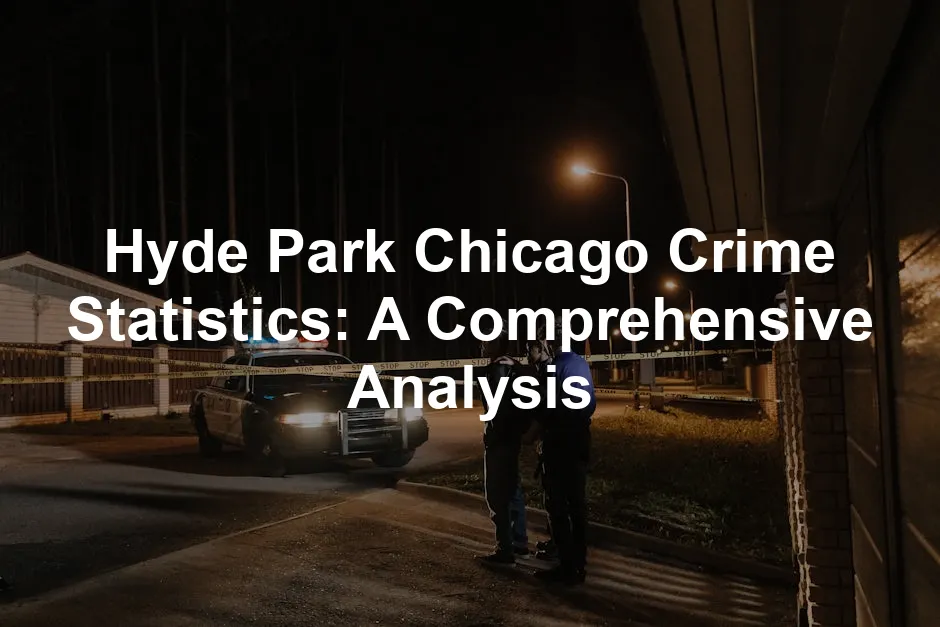Introduction
Hyde Park is a vibrant neighborhood nestled on the South Side of Chicago. Known for its rich history and as the home of the prestigious University of Chicago, it offers a unique blend of academic life and residential charm. The neighborhood boasts beautiful architecture, lush parks, and a strong sense of community. However, like any urban setting, understanding crime statistics is vital for residents, potential movers, and city planners alike.
Knowing the crime landscape helps current residents make informed decisions about their safety. For those considering a move, crime data can significantly influence their choice of neighborhood. City planners rely on these statistics to allocate resources and implement safety initiatives. Therefore, this article aims to provide an in-depth analysis of Hyde Park’s crime statistics. We will compare these figures to national and Chicago averages, shedding light on safety perceptions within the community.
By examining crime data, we can uncover patterns, trends, and insights that help paint a clearer picture of life in Hyde Park. Through this exploration, readers will gain a comprehensive understanding of the safety dynamics at play, enabling them to navigate the neighborhood with confidence.

Understanding Crime Statistics
What Are Crime Statistics?
Crime statistics refer to the systematic collection and analysis of data related to criminal activities. These statistics are essential in urban studies, providing insights into the safety and security of communities. They help identify trends, patterns, and areas that require intervention. Crime statistics are typically divided into two main categories: violent crimes and property crimes.
Violent crimes include offenses such as homicide, assault, and robbery. These crimes often involve direct harm to individuals and are taken very seriously by law enforcement. Property crimes, on the other hand, encompass burglary, theft, and vandalism. While these crimes do not typically involve physical harm to individuals, they can have significant psychological and financial impacts on victims.
The reporting of crime statistics is crucial, as it ensures that data is accurate and reflective of actual incidents. Reliable statistics help law enforcement agencies allocate resources effectively and develop targeted crime prevention strategies.
Sources of Crime Data
Crime data comes from various reliable sources that work together to provide a comprehensive view of the situation. The Chicago Police Department (CPD) plays a significant role in collecting and reporting crime statistics, utilizing their extensive network of officers and resources.
The FBI’s Uniform Crime Reporting (UCR) Program is another vital source of national crime data. This program compiles information from over 18,000 law enforcement agencies, allowing for a broader understanding of crime trends across the country.
Additionally, the University of Chicago Police Department (UCPD) contributes to crime data collection, particularly concerning incidents on and around the university campus. The UCPD provides quarterly updates on crime statistics, covering not only the university but also the surrounding neighborhoods, including Hyde Park.
These sources are essential for providing accurate and up-to-date information. By utilizing multiple reporting agencies, we can achieve a more nuanced understanding of crime in Hyde Park and its context within the broader Chicago landscape.

And speaking of understanding crime, if you’re looking for a thought-provoking read on the subject, consider diving into Crime and Punishment by Fyodor Dostoevsky. This classic novel explores the moral dilemmas of crime and retribution, offering a deep dive into the human psyche.
Overview of Crime in Hyde Park
Current Crime Rates
Hyde Park’s crime rates offer a fascinating glimpse into safety in this vibrant neighborhood. According to recent data, the total crime rate in Hyde Park is approximately 11% higher than the national average. However, a closer look reveals that violent crimes are 21% lower than the national average. Let’s break down the numbers to get a clearer picture.
Here’s a snapshot of the crime statistics for Hyde Park compared to Chicago, Illinois, and national averages:
| Statistic | Hyde Park / 100k people | Chicago / 100k people | Illinois / 100k people | National / 100k people |
|---|---|---|---|---|
| Total Crime | 2,591 (estimate) | 3,673 | 1,970 | 2,324 |
| Murder | n/a | 22.8 | 7.8 | 6.3 |
| Rape | n/a | 51.8 | 48.1 | 40.0 |
| Robbery | n/a | 337.4 | 84.7 | 66.1 |
| Assault | n/a | 128.0 | 146.7 | 268.2 |
| Violent Crime | 292 (estimate) | 540 | 287 | 370 |
| Burglary | n/a | 287.5 | 208.5 | 269.8 |
| Theft | n/a | 2,046.4 | 1,192.7 | 1,401.9 |
| Vehicle Theft | n/a | 799.0 | 281.6 | 282.7 |
| Property Crime | 2,299 (estimate) | 3,133 | 1,683 | 1,954 |

Violent crime incidents in Hyde Park include an estimated 292 occurrences per 100,000 people. In comparison, Chicago’s rate is significantly higher at 540. While property crime rates in Hyde Park stand at an estimated 2,299, Chicago’s statistics reveal a higher figure of 3,133.
If you’re interested in understanding the factors that contribute to crime, check out The Anatomy of Violence: The Biological Roots of Crime by Adrian Raine. This book delves into the biological and social factors that can lead to criminal behavior, offering a fascinating perspective on the nature of crime.
Historical Crime Trends
Over the past decade, Hyde Park has experienced notable shifts in crime rates. The neighborhood reflects a complex narrative that includes fluctuating levels of both violent and property crimes.
From 2012 to 2022, Hyde Park’s violent crime rates have seen a gradual decline, aligning with citywide trends in Chicago. However, property crimes, particularly theft and burglary, have remained more stable, indicating a persistent challenge. Graphs or infographics illustrating these trends can effectively showcase the upward and downward trajectories of crime rates over this period.
Such visual aids could highlight a peak in property crime around 2017, followed by a gradual reduction. Meanwhile, violent crime has consistently trended downwards, suggesting that community initiatives and policing strategies are having a positive effect.

Safety Perceptions in the Community
Understanding how residents feel about safety in Hyde Park is equally important. Surveys reveal an intriguing perspective on community safety. Among the respondents, 62% stated they feel pretty safe overall. However, 23% admitted to having some safety concerns.
Interestingly, perceptions of safety can vary dramatically depending on one’s location within the neighborhood. Areas near the University of Chicago generally feel more secure. Conversely, regions further from the university, especially near Washington Park, tend to raise more eyebrows in terms of safety.
Law enforcement visibility plays a significant role in shaping these perceptions. According to survey results, 57% of respondents believe that police presence is strong and responsive. On the other hand, 36% feel that while the police are visible, their response time could be improved.
This blend of statistics and personal sentiments paints a nuanced picture of crime and safety in Hyde Park. By combining factual data with community feedback, we can appreciate the complexity of life in this storied neighborhood.

Crime Comparisons: Hyde Park vs. Chicago and National Averages
Violent Crime Comparison
When it comes to violent crime, Hyde Park has some impressive stats. In fact, violent crime rates in this neighborhood are 21% lower than the national average. The estimated violent crime rate in Hyde Park is about 292 incidents per 100,000 people. To put that into perspective, Chicago itself has a much higher rate of 540 per 100,000.
Let’s break it down further. Here are the specific statistics for violent crime categories:
- Homicide: Chicago reports 22.8 homicides per 100,000 people. Hyde Park, on the other hand, doesn’t report any homicides in recent data, showcasing its relative safety.
- Rape: Chicago experiences a rate of 51.8, while Hyde Park’s statistics are not readily available, indicating a relative lack of reported incidents.
- Robbery: The rate in Chicago hits 337.4, whereas Hyde Park’s numbers are again absent, suggesting fewer occurrences.
- Assault: Chicago reports 128 assaults per 100,000 people compared to Hyde Park, where the data remains elusive but suggests a significantly lower figure.

Hyde Park’s crime landscape is marked by a community that enjoys a lower risk of violent crime compared to both the city and national averages. Residents can breathe a little easier knowing they are in a relatively safe haven.
Property Crime Comparison
Now, let’s pivot to property crimes. In Hyde Park, the property crime rate stands at an estimated 2,299 incidents per 100,000 people. Comparatively, Chicago’s rate is notably higher at 3,133. This difference highlights Hyde Park as a more secure environment for property.
The types of property crimes prevalent in Hyde Park typically include burglary, theft, and vehicle theft. While specific statistics for each type are not always available, residents often report concerns about vehicle break-ins and theft of personal belongings. However, the overall trend shows that property crime in Hyde Park is considerably less frequent than in many other neighborhoods across Chicago.

For those concerned about home security, consider investing in a Home Security Camera System. This device allows you to monitor your property in real-time, providing peace of mind when you’re away from home.
Neighborhood Context
When comparing Hyde Park to nearby neighborhoods like Kenwood and Washington Park, the differences in crime statistics become evident. Kenwood, known for its affluence, generally experiences lower crime rates, making it a desirable area for families. Washington Park, however, has higher crime rates, particularly with violent crimes, which can create a stark contrast.
Socio-economic factors play a significant role in these crime rates. Hyde Park’s proximity to the University of Chicago contributes to a more engaged community, often leading to increased safety measures and community policing initiatives. In contrast, Washington Park faces challenges related to economic disparity, which can correlate with higher crime rates.
Hyde Park’s crime statistics, when viewed alongside those of its neighbors, reveal a neighborhood that manages to maintain a sense of safety amidst the complexities of urban living. Residents enjoy a community that is not only rich in culture and history but also stands as a relative oasis of safety compared to both the city and national averages.

Safety Measures and Community Initiatives
Policing and Law Enforcement
In Hyde Park, safety is a community affair, thanks to the diligent efforts of the University of Chicago Police Department (UCPD) and the Chicago Police Department (CPD). The UCPD is responsible for patrolling the university campus and surrounding areas, extending their reach into Hyde Park. This partnership amplifies safety through proactive measures and community-oriented policing strategies.
Community policing has taken center stage in Hyde Park. UCPD and CPD emphasize building trust with residents. Regular community meetings allow residents to voice concerns directly to police officers. This open dialogue fosters a sense of collaboration, ensuring that law enforcement addresses the community’s specific needs.
Both departments often conduct safety programs, such as self-defense classes and safety workshops. These initiatives educate residents on how to protect themselves and their property. They also promote awareness about crime trends in the area. For example, the UCPD releases quarterly crime statistics, shedding light on recent incidents and helping residents stay informed. By making crime data accessible, both departments empower the community to take action.

Community Engagement
Hyde Park is not just a place to live; it’s a community united by a common goal: safety. Numerous community programs work tirelessly to reduce crime and enhance safety. Initiatives like “Neighbors Together” encourage residents to participate in neighborhood watch programs. These programs cultivate camaraderie among residents, making it easier to spot suspicious activities.
One notable community initiative is the “Hyde Park Safe Neighborhood Program.” This project focuses on fostering engagement through regular meetings, where residents can discuss safety concerns and share tips. The program also provides resources for residents to report crime anonymously, ensuring everyone feels safe speaking up.
Residents play a crucial role in maintaining safety. Many volunteer to patrol their streets, equipped with knowledge from safety training sessions. This involvement not only deters crime but also strengthens community bonds. The more eyes on the street, the less likely crime is to flourish.

Resources for Residents
Hyde Park residents have access to an array of resources designed to enhance their safety. For instance, mobile safety apps like “UChicago Safe” provide instant access to emergency contacts, safety alerts, and campus resources. Such tools are invaluable, especially for those who may feel vulnerable after dark.
Additionally, the “cAlert” system keeps residents informed about local emergencies and safety alerts. This service sends notifications directly to subscribers’ phones, ensuring that everyone stays updated on potential threats or safety measures in real-time.
For those seeking more traditional resources, both the UCPD and CPD maintain websites filled with tips on crime prevention. Residents can find information on securing their homes, safe driving practices, and how to report suspicious activities. These resources are essential for fostering a proactive safety culture within the community.
In summary, Hyde Park is not just a neighborhood; it’s a vibrant community committed to safety. Through collaborative policing efforts, community engagement, and accessible resources, residents can feel more secure. The proactive measures taken by law enforcement and community members alike create an environment where everyone can thrive.

Conclusion
In summary, Hyde Park presents a mixed picture when it comes to crime statistics. While the total crime rate here is approximately 11% higher than the national average, the neighborhood shines when it comes to violent crime, which is about 21% lower than the national average. This suggests that, despite some challenges, Hyde Park is relatively safe compared to many other urban areas. Residents enjoy a lower risk of violent crime, with an estimated 292 incidents per 100,000 people, in stark contrast to Chicago’s higher rate of 540.
Understanding these statistics is crucial for both current residents and those considering a move to Hyde Park. Knowledge of crime trends helps residents make informed decisions about their safety and well-being. It also empowers newcomers to choose wisely when looking for the right place to call home.
Moreover, the perceptions of safety within the community play a significant role. Surveys indicate that a majority of residents feel safe, but there are notable concerns in certain areas, particularly further away from the university’s protective presence. Engaging with community initiatives and staying informed about local crime trends can foster a sense of security and connectedness.
Residents are encouraged to participate in neighborhood watch programs and local meetings to discuss safety concerns. A well-informed community is a safer community. By understanding crime statistics and actively engaging with one another, residents can promote a safer environment in Hyde Park. Learn more about crime statistics in Hyde Park.

FAQs
What is the overall crime rate in Hyde Park?
Hyde Park’s crime rate stands at an estimated 2,591 incidents per 100,000 people. This is around 11% higher than the national average. However, it’s essential to note that the violent crime rate here is about 21% lower than the national average, indicating a relatively safe environment for residents.
How does Hyde Park’s crime rate compare to the rest of Chicago?
When compared to Chicago, Hyde Park has a lower violent crime rate of 292 incidents per 100,000 people, while Chicago’s average is 540. However, Hyde Park does experience a higher property crime rate, which stands at 2,299 compared to Chicago’s 3,133.
Are there specific areas in Hyde Park that are safer than others?
Yes, certain areas in Hyde Park, particularly near the University of Chicago, are perceived as safer. Residents living close to the university often report feeling more secure than those in neighborhoods further away, such as areas bordering Washington Park, which have higher crime rates.
What should residents do if they feel unsafe?
If residents feel unsafe, they should first reach out to local law enforcement or community policing programs for support. Getting involved in neighborhood watch initiatives or community meetings can also be beneficial. Additionally, utilizing safety apps like “UChicago Safe” or subscribing to the cAlert system can keep residents informed about local safety alerts.
How can I access detailed crime statistics for Hyde Park?
Residents can access detailed crime statistics through several resources. The Chicago Police Department (CPD) offers a searchable crime database on their website. Additionally, the University of Chicago Police Department (UCPD) provides quarterly updates on crime statistics in the area. For comprehensive campus and neighborhood data, visit the UCPD’s crime data trends page.
Please let us know what you think about our content by leaving a comment down below!
Thank you for reading till here 🙂
For a comprehensive analysis of safety in 2023, you can check out the Fremont crime statistics.
And for a gripping read on the justice system, don’t miss Just Mercy: A Story of Justice and Redemption by Bryan Stevenson. This powerful memoir sheds light on the flaws in the justice system and the importance of compassion.
All images from Pexels




